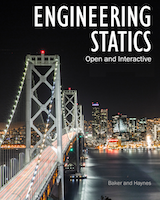Section 8.10 Summary
You have likely realized that in engineering (and life) that there are multiple ways to solve a problem. The four different techniques to compute internal forces discussed in this chapter are a demonstration of this. In the end, the choice of which method to use is yours; the better you know each method the easier it will be to choose the one which is most applicable and efficient.
The list below summarizes each of the four approaches and their advantages and disadvantages.
-
In Section 8.3 we exposed the internal forces at a specific point inside a rigid body by taking a cut at that location and applying the equilibrium equations. This approach is computationally efficient, works for any rigid body and takes advantage of tools you have learned in previous chapters. It requires knowledge of sign conventions for internal shear and bending moments, but only reveals values at the selected point.
-
In Section 8.6 we generalized the previous approach by taking a cut at a variable location, and analyzed the equilibrium equations in terms of \(x\text{.}\) The results were functions which describe shear and moment at every point within the beam, rather than at a specific location. This method requires breaking a beam into loading segments and writing and solving equations for each segment. The equations are then plotted to give shear and bending moment diagrams.
-
In Section 8.7 we used the mathematical relationships between loading, shear, and bending moment to draw shear and moment diagrams directly. The method is quick and requires only a few simple computations to determine the critical values. The approach provides many cross-checks for accuracy. It is most suitable for beams loaded with concentrated forces, concentrated moments, and uniformly distributed loads, but is not usually suitable for more complex distributed loads. It is essential to have a solid grasp of the integral and differential relations between loading, shear and moment discussed in Section 8.5 to use this method.
-
In Section 8.8 we discussed the most general approach to determine internal loads. In the approach, the load is described as a piecewise function of \(x\text{,}\) which is integrated twice to develop equations for shear and moment. This method can used for arbitrarily complicated loading distributions, and can be used by software solutions. Applying this method by hand requires accurate integration and differentiation, and application of boundary conditions.

